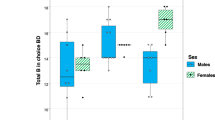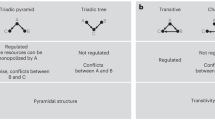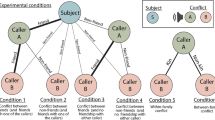Abstract
Living in large, stable social groups is often considered to favour the evolution of enhanced cognitive abilities, such as recognizing group members, tracking their social status and inferring relationships among them1,2,3,4. An individual's place in the social order can be learned through direct interactions with others, but conflicts can be time-consuming and even injurious. Because the number of possible pairwise interactions increases rapidly with group size, members of large social groups will benefit if they can make judgments about relationships on the basis of indirect evidence5. Transitive reasoning should therefore be particularly important for social individuals, allowing assessment of relationships from observations of interactions among others. Although a variety of studies have suggested that transitive inference may be used in social settings6,7,8,9,10, the phenomenon has not been demonstrated under controlled conditions in animals. Here we show that highly social pinyon jays (Gymnorhinus cyanocephalus) draw sophisticated inferences about their own dominance status relative to that of strangers that they have observed interacting with known individuals. These results directly demonstrate that animals use transitive inference in social settings and imply that such cognitive capabilities are widespread among social species.
This is a preview of subscription content, access via your institution
Access options
Subscribe to this journal
Receive 51 print issues and online access
$199.00 per year
only $3.90 per issue
Buy this article
- Purchase on Springer Link
- Instant access to full article PDF
Prices may be subject to local taxes which are calculated during checkout



Similar content being viewed by others
References
Jolly, A. Lemur social behavior and primate intelligence. Science 153, 501–506 (1966)
Humphrey, N. K. in Growing Points in Ethology (eds Bateson, P. & Hinde, R. A.) 303–317 (Cambridge Univ. Press, Cambridge, 1976)
Kummer, H., Daston, L., Gigerenzer, G. & Silk, J. in Human by Nature: Between Biology and the Social Sciences (ed. Weingart, P. et al.) 157–179 (L. Erlbaum, Hillsdale, 1997)
de Waal, F. B. M. & Tyack, P. L. Animal Social Complexity (Harvard Univ. Press, Cambridge, 2003)
Seyfarth, R. M. & Cheney, D. L. in Animal Social Complexity (eds de Waal, F. B. M. & Tyack, P. L.) 207–229 (Harvard Univ. Press, Cambridge, 2003)
Cheney, D. L. & Seyfarth, R. M. Vocal recognition in free-ranging vervet monkeys. Anim. Behav. 28, 362–367 (1980)
Holekamp, K. E. et al. Vocal recognition in the spotted hyena and its possible implications regarding the evolution of intelligence. Anim. Behav. 58, 383–395 (1999)
Silk, J. B., Seyfarth, R. M. & Cheney, D. L. The structure of social relationships among female baboons. Behaviour 136, 679–703 (1999)
Peake, T. M., Terry, A. M. R., McGregor, P. K. & Dabelsteen, T. Do great tits assess rivals by combining direct experience with information gathered by eavesdropping? Proc. R. Soc. Lond. B 269, 1925–1929 (2002)
Bergman, T. J., Beehner, J. C., Cheney, D. L. & Seyfarth, R. M. Hierarchical classification by rank and kinship in baboons. Science 302, 1234–1236 (2003)
Balda, R. P. in The Birds of North America No. 605 (eds Poole, A. & Gill, F.) 1–32 (Birds of North America Inc., Philadelphia, 2002)
Marzluff, J. M. & Balda, R. P. The Pinyon Jay (T. & A.D. Poyser, London, 1992)
Bond, A. B., Kamil, A. C. & Balda, R. P. Social complexity and transitive inference in corvids. Anim. Behav. 65, 479–487 (2003)
Balda, R. P., Kamil, A. C. & Bednekoff, P. A. in Current Ornithology 13 (eds Nolan, V. & Ketterson, E. D.) 33–66 (Plenum, New York, 1996)
Chase, I., Bartolomeo, C. & Dugatkin, L. A. Aggressive interactions and inter-contest interval: how long do winners keep winning? Anim. Behav. 48, 393–400 (1994)
Hogue, M.-E., Beaugrand, J. P. & Laguë, P. C. Coherent use of information by hens observing their former dominant defeating or being defeated by a stranger. Behav. Processes 38, 241–252 (1996)
Oliveira, R. F., McGregor, P. K. & Latruffe, C. Know thine enemy: fighting fish gather information from observing conspecific interactions. Proc. R. Soc. Lond. B 265, 1045–1049 (1998)
SAS v.8 (SAS Institute Inc., Cary, North Carolina, 2000).
Rohwer, S. The evolution of reliable and unreliable badges of fighting ability. Am. Zool. 22, 531–546 (1982)
Huntingford, F. A. & Turner, A. K. Animal Conflict (Chapman and Hall, London, 1987)
Acknowledgements
We thank N. Howe and E. A. Simpson for assistance in data collection and B. Luke Stafford for help in designing Fig. 1. Supported by University of Nebraska Research Enhancement Funds and an NSF grant to Northern Arizona University.
Author information
Authors and Affiliations
Corresponding authors
Ethics declarations
Competing interests
The authors declare that they have no competing financial interests.
Rights and permissions
About this article
Cite this article
Paz-y-Miño C, G., Bond, A., Kamil, A. et al. Pinyon jays use transitive inference to predict social dominance. Nature 430, 778–781 (2004). https://doi.org/10.1038/nature02723
Received:
Accepted:
Issue Date:
DOI: https://doi.org/10.1038/nature02723
This article is cited by
-
Why are ravens smart? Exploring the social intelligence hypothesis
Journal of Ornithology (2024)
-
The cognitive challenges of cooperation in human and nonhuman animals
Nature Reviews Psychology (2023)
-
Human and animal dominance hierarchies show a pyramidal structure guiding adult and infant social inferences
Nature Human Behaviour (2023)
-
Heuristics Facilitates the Evolution of Transitive Inference and Social Hierarchy in a Large Group
Acta Biotheoretica (2023)
-
Learning and organization of within-session sequences by pigeons (Columba livia)
Animal Cognition (2023)
Comments
By submitting a comment you agree to abide by our Terms and Community Guidelines. If you find something abusive or that does not comply with our terms or guidelines please flag it as inappropriate.



